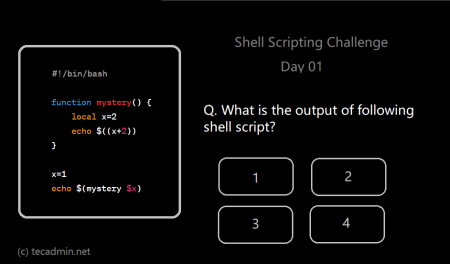Bash is a powerful scripting language that is widely used in Linux and Unix environments for automation and system administration. With Bash scripting, system administrators can automate repetitive tasks, manage servers, and perform complex operations. However, mastering Bash scripting requires more than just basic knowledge of syntax and variables.
In this article, we will explore some advanced Bash scripting techniques and best practices that can help you become a more proficient Bash programmer.
1. Modularizing your code
When scripting in Bash, it is essential to write modular and reusable code. Modularity allows you to separate functionality into smaller, more manageable scripts that can be reused across different projects or environments. This can save time and reduce errors. You can achieve modularity in Bash by creating functions, libraries, and modules.
1 2 3 4 5 6 7 8 9 10 11 12 13 14 15 16 17 18 19 20 21 22 23 24 | #!/bin/bash # Function to calculate sum function calculate_sum { return $(($1 + $2)) } # Function to exit script on error function exit_on_error { echo $1 | tea -a /var/log/custom_error.log exit 1 } # Function to install MySQL database server function install_package { sudo apt-get update sudo apt-get install $1 -y } # Main script calculate_sum 2 4 install_mysql install_php |
2. Handling Errors and Exceptions
As with any programming language, errors and exceptions can occur in Bash scripts. Therefore, it is crucial to handle errors and exceptions properly to ensure that your scripts run smoothly and efficiently. You can use the ‘set -e’ command to terminate the script immediately if an error occurs. Additionally, you can use the ‘trap’ command to catch signals and handle exceptions gracefully.
1 2 3 4 5 6 7 8 9 10 11 12 13 14 15 16 17 18 19 20 21 22 | #!/bin/bash set -e trap "echo 'Error: Script terminated' >&2" ERR # Command to check if a file exists if [ ! -f /path/to/file ]; then echo 'Error: File does not exist' >&2 exit 1 fi # Command to remove a file rm /path/to/file || { echo 'Error: Unable to remove file' >&2 exit 1 } # Command to restart Apache web server sudo service apache2 restart || { echo 'Error: Unable to restart Apache' >&2 exit 1 } |
In this example, we have used the ‘set -e’ command to terminate the script immediately if an error occurs. We have also used the ‘trap’ command to catch signals and handle exceptions gracefully.
3. Using Arrays and Associative Arrays
Bash supports both indexed and associative arrays, which can be used to store and manipulate data efficiently. An indexed array is a collection of elements that are stored in a specific order, while an associative array is a collection of key-value pairs. You can use arrays to store command output, process files, and perform other operations.
1 2 3 4 5 6 7 8 9 10 11 12 | #!/bin/bash # Indexed array example fruits=("apple" "banana" "orange" "grape") echo "The second fruit is ${fruits[1]}" # Associative array example declare -A colors colors["red"]="#FF0000" colors["green"]="#00FF00" colors["blue"]="#0000FF" echo "The color for green is {colors['green']}" |
In this example, we have created an indexed array and an associative array to store and manipulate data efficiently. We have used the indexed array to access elements by index, and the associative array to access elements by key.
4. Working with Regular Expressions
Regular expressions are powerful tools that allow you to search, replace, and manipulate text. In Bash, you can use regular expressions in many ways, such as pattern matching, string manipulation, and input validation. Regular expressions use special characters to represent patterns, which can be used to match or replace parts of a string.
1 2 3 4 5 6 7 8 9 10 11 | #!/bin/bash # Command to extract domain from email address email="john.doe@example.com" domain=$(echo $email | grep -oP '(?<=@)[^.]+.[^.]+') echo "The domain is $domain" # Command to replace all instances of "foo" with "bar" text="This is a foo bar sentence." new_text=$(echo $text | sed 's/foo/bar/g') echo "The new text is $new_text" |
In this example, we have used regular expressions to extract a domain from an email address and replace a string in a sentence.
5. Debugging Bash Scripts
Debugging is an essential part of the development process. Bash provides several debugging tools that can help you identify and fix errors in your scripts. You can use the ‘-x’ option to enable debugging mode, which prints each command before it is executed. You can also use the ‘set -u’ option to detect undefined variables.
1 2 3 4 5 6 7 8 9 10 | #!/bin/bash set -x set -u # Command to concatenate two strings str1="Hello" str2="World" result=$str1$str2 echo $result |
In this example, we have used the ‘-x’ option to enable debugging mode, which prints each command before it is executed. We have also used the ‘set -u’ option to detect undefined variables. This can help us identify and fix errors in our scripts.
Conclusion
Bash scripting is a powerful tool for system administrators and developers alike. By using the techniques and best practices discussed in this article, you can write more efficient and robust Bash scripts that can automate a wide range of tasks. By mastering advanced Bash scripting techniques, you can become a more proficient programmer and take your automation and system administration skills to the next level.
